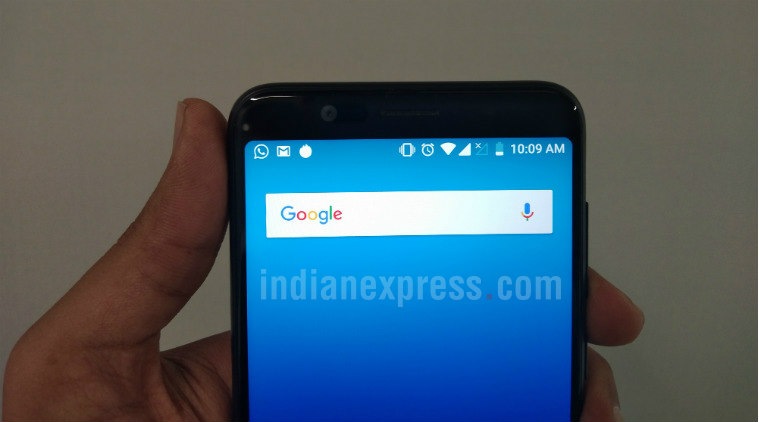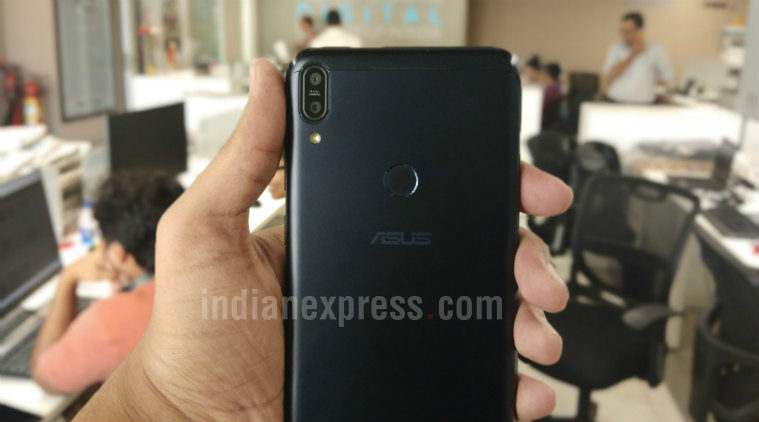 Asus Zenfone Max Pro M1 goes on sale today. Despite its impressive specifications is it worth its asking price? Let’s find out in our review.
Asus Zenfone Max Pro M1 goes on sale today. Despite its impressive specifications is it worth its asking price? Let’s find out in our review.
Asus recently launched the Zenfone Max Pro M1 in India at the starting price of Rs 10,999. It aims to compete with the likes of Xiaomi’s Redmi Note 5 Pro, which is a best-seller in India’s mid-range (sub-Rs 20K) smartphone segment. As far as few specs are concerned, both the handsets are identical. But there are differences as well, courtesy of 5000mAh battery and stock Android 8.1 Oreo on the Zenfone Max Pro M1, unlike a 4000mAh battery and Android Nougat-based custom MIUI 9 skin on the Redmi Note 5 Pro. So, is the Zenfone Max Pro M1 a viable alternative to the Redmi Note 5 Pro? Let’s find out in our review:
Asus Zenfone Max Pro M1 specifications
Display: 5.99-inch (2,160 x 1,080) | Operating system: Android 8.1 Oreo | RAM: 3GB/4GB | Storage: 32GB/64GB (expandable up to 400GB) | Rear camera: 13MP + 5MP | Front camera: 8MP | Dimensions: 159 x 76 x 8.61 mm | Weight: 180 g | Battery: 5,000mAh | Connectivity options: 4G VoLTE, Bluetooth 4.2, Wi-Fi, GPS and 3.5mm audio jack
Asus Zenfone Max Pro M1 price in India
Rs 10,999 for 3GB of RAM and 32GB internal storage and Rs 12,999 for 4GB of RAM and 64GB internal storage
Asus Zenfone Max Pro M1: Display and design review
These days we have seen a lot of phones with a full-screen display with a notch being released in India, but the Asus Zenfone Max Pro M1 isn’t one of them. This one hasn’t been inspired by Apple iPhone X for a change. Sure, bezels are trimmed down a little bit which is a standard fare in 2018. I personally appreciate it because not so long ago, brands like Vivo and Oppo announced their mid-range handsets (Vivo V9 and Oppo F7) having a face value of the iPhone X. But when it comes to breaking a sweat, they are just as normal as any other mid-range phones out there.
Thanks to 18:9 aspect ratio, it has this not-so-huge-looking 5.99-inch IPS panel on the front accompanied by slim bezels, making it look compact and easy to handle using one hand. I personally prefer phones that aren’t too big and easy to carry around in my pocket, and I must say that I’m impressed with Asus Zenfone Max Pro M1 on that front. The handset weighs 180g with battery. That sounds heavy, but in reality it doesn’t feel that heavy or bulky despite a 5,000mAh battery lying under the hood.
Overall screen quality is praiseworthy. Brightness and colour accuracy are some of its plus points. Viewing angles are great too. Interacting with the display feels nice and somewhat premium. However, when you take the phone outside under bright sunlight, the screen is barely readable, which has often been the case with most of the budget and mid-range offerings from various brands out there. It works well indoors, nonetheless.
 Asus Zenfone Max Pro M1 supports adaptive brightness so that it can adjust automatically on its own depending on the surroundings. The default screen tone isn’t dull.
Asus Zenfone Max Pro M1 supports adaptive brightness so that it can adjust automatically on its own depending on the surroundings. The default screen tone isn’t dull.
Although it has a 2.5D arc glass layered on top, it fails to offer Corning Gorilla Glass protection or an oleophobic coating. Up front it is a fingerprint magnet and there’s literally nothing you can do about it other than keep cleaning it, which is bad. But if you prefer to ignore these deficiencies, which I feel you should given the affordability and Full HD+ screen resolution of 2,160 x 1,080 pixels, it’s worth every penny.
It supports adaptive brightness so that it can adjust automatically on its own depending on the surroundings. The default screen tone isn’t dull. In fact, it’s seems somewhere in the middle of Cool and Warm. As far as design is concerned, you get an aluminium unibody along with a couple of plastic caps, fingerprint reader and Asus branding on the rear. It is 8.6mm thin that kind of feels like an ideal form factor for the handset, and again, quite impressive given its mammoth battery. It has enough room to accomodate a 3.5mm audio jack at the bottom, in addition to a primary microphone, microUSB 2.0 port and speakers grill.
Asus Zenfone Max Pro M1: Hardware performance and gaming review
Asus Zenfone Max Pro M1 has two configurations: 3GB of RAM with 32GB of internal storage and 4GB of RAM with 64GB of internal storage. We got the former for review. Now, here’s something I’ve been wondering since the time I started using this handset as my daily driver: Why did Asus launch a 3GB RAM variant in the first place? Because it’s worth pointing out that Asus has talked a lot (I mean literally, A LOT) about how their phone performs better than the Redmi Note 5 Pro by offering the same (Qualcomm Snapdragon 636 octa-core) chipset. But then Asus also wants you to deal with an inferior 3GB of RAM variant at the same time, which is somewhat weird.
The point I’m making here is simple – firstly, this isn’t a fair competition. Xiaomi Redmi Note 5 Pro starts at 4GB of RAM unlike Asus. Secondly, a 3GB RAM variant on the Zenfone Max Pro M1 is a deal-breaker. It hasn’t been able to leverage the power of Qualcomm’s Snapdragon 636 SoC to its full potential. In two separate incidents, apps like Gmail and AnTuTu crashed all of a sudden. Multi-browser tests didn’t go well either. There was a noticeable lag while switching between tabs across different web browsers like Chrome, Firefox and Microsoft Edge. However, overall experience with general multitasking during day to day usage was just about fine. If you keep switching between the tasks back and forth, you can expect the handset to get a little bit warm eventually, which is normal, but nothing to worry about.
 Asus Zenfone Max Pro M1 beats the Redmi Note 5 Pro with an AnTuTu score of 114469. Similarly, on Geekbench, it recorded 1334 single-core score and 4787 multi-score score.
Asus Zenfone Max Pro M1 beats the Redmi Note 5 Pro with an AnTuTu score of 114469. Similarly, on Geekbench, it recorded 1334 single-core score and 4787 multi-score score.
Let me clarify that my experience is limited to a 3GB RAM variant. So, if you are planning to go for the high-end variant, do keep in mind that your experience may turn out to be different. Games like Asphalt 8, Dead Trigger 2 and Modern Combat 5 ran just fine and the handset didn’t face any kind of lag or stutters whatsoever. But notably enough, battery temperature went up to 42-degree after 20 minutes of continuous gaming. Asus Zenfone Max Pro M1 beats the Redmi Note 5 Pro with an AnTuTu score of 114469. Similarly, on Geekbench, it recorded 1334 single-core score and 4787 multi-score score.
For security, it provides fingerprint scanner and face unlock mechanisms. Although fingerprint reader isn’t the fastest out there, it worked flawlessly every time I tried to unlock the handset. Similar is the case with face unlock, which is impressive. Oh yes, face unlock finally works after the last update.
Asus Zenfone Max Pro M1: Camera review
Let me come straight to the point. Asus Zenfone Max Pro M1 has no expertise in the camera department. But it’s decent enough to get the job done. It houses 13MP + 5MP dual rear cameras with LED flash. Yes, there’s a secondary depth-sensing camera to let you capture portrait shots with bokeh effect. I’ve captured photos in every lighting situation i.e., natural light, low light, indoor, at night etc. When in natural lighting conditions, the images feel a little sharpened and colours feel a tad unnatural, but not a deal breaker given its price. Photos taken indoor on the other hand, suffer from inaccurate white balance. However, if you configure white balance settings from ‘Auto’ to ‘Daylight,’ you’ll end up capturing near-perfect colours indoors.
Surprisingly enough, night and low light shots on Asus Zenfone Max Pro M1 end up retaining details to a great extent. However, you have to be extra careful and ensure that your hand is steady and the object isn’t moving. As you can see with some of the sample pictures I captured at Mumbai’s Chhatrapati Shivaji Maharaj Terminus, they retained some minor details too. However, colours often tilt. So, you have to be careful with the focusing as well as movement. What leaves me disappointed is the sluggish camera viewfinder that often takes longer than normal to function. Shutter speed has also been poor even in decent lighting conditions.
 Asus Zenfone Max Pro M1 houses 13MP + 5MP dual rear cameras with LED flash. Yes, there’s a secondary depth-sensing camera to let you capture portrait shots with bokeh effect.
Asus Zenfone Max Pro M1 houses 13MP + 5MP dual rear cameras with LED flash. Yes, there’s a secondary depth-sensing camera to let you capture portrait shots with bokeh effect.
Asus Zenfone Max Pro M1 has a lot of shooting modes to offer such as HDR, Portrait, Candlelight, Beach etc. I captured a few portrait shots and they came out really well. It can accurately blur the background for more appealing shots. However, you have to keep your hands steady while taking photos for better-looking portrait shots. Up front is an 8MP camera for selfies and video calls. What’s interesting here is the fact that it also allows you to take selfies with bokeh effect. I clicked some selfies in different lighting conditions. This isn’t a selfie expert, but then it’s not even claiming to be one. End results lack details and ends up capturing selfies that are often shaky and noisy. The rear cameras on the M1 can also record up to 4K videos at 30 frames per second (fps).
Asus Zenfone Max Pro M1: Camera samples
 Asus Zenfone Max Pro M1 can accurately blur the background for more appealing shots. However, you have to keep your hands steady while taking photos for better-looking portrait shots. (Image resized for web).
Asus Zenfone Max Pro M1 can accurately blur the background for more appealing shots. However, you have to keep your hands steady while taking photos for better-looking portrait shots. (Image resized for web).
 As you can see with some of the sample pictures I captured at Mumbai’s Chhatrapati Shivaji Maharaj Terminus, they retained some minor details too. (Image resized for web).
As you can see with some of the sample pictures I captured at Mumbai’s Chhatrapati Shivaji Maharaj Terminus, they retained some minor details too. (Image resized for web).
 When in natural lighting conditions, the images feel a little sharpened and colours feel a tad unnatural, but not a deal breaker given its price. (Image resized for web).
When in natural lighting conditions, the images feel a little sharpened and colours feel a tad unnatural, but not a deal breaker given its price. (Image resized for web).
 Asus Zenfone Max Pro M1 isn’t a selfie expert, but then it’s not even claiming to be one. End results lack details and ends up capturing selfies that are often shaky and noisy. (Image resized for web).
Asus Zenfone Max Pro M1 isn’t a selfie expert, but then it’s not even claiming to be one. End results lack details and ends up capturing selfies that are often shaky and noisy. (Image resized for web).
Asus Zenfone Max Pro M1: Software and battery review
One of the key highlights of Asus Zenfone Max Pro M1 is that it runs a pure Android 8.1 Oreo out-of-the-box. For the first time, Asus decided to ditch ZenUI in favour of a stock Android experience. I’ve never liked Asus ZenUI much, so it’s a good decision. But unfortunately, running stock Android doesn’t mean it’s free of bloatware. Adding to my disappointment, Asus bundles certain apps like Facebook, Messenger, Instagram and Go2Pay that you can’t uninstall. Out of 32GB, around 9GB space was already consumed by the OS and preinstalled apps itself. Also, given that it promises a pure Android experience, there’s an app drawer for installed apps and games.
 One of the key highlights of Asus Zenfone Max Pro M1 is that it runs a pure Android 8.1 Oreo out-of-the-box. For the first time, Asus decided to ditch ZenUI in favour of a stock Android experience.
One of the key highlights of Asus Zenfone Max Pro M1 is that it runs a pure Android 8.1 Oreo out-of-the-box. For the first time, Asus decided to ditch ZenUI in favour of a stock Android experience.
Asus’ Zenfone Max-series lineup has always been about big battery smartphones, and the Zenfone Max Pro M1 is no different. It packs a massive 5,000mAh battery under the hood that should comfortably last over a day’s usage. But unfortunately, the handset tells a different story. Contrary to what I was expecting out of the Zenfone Max Pro M1, the handset often ran out of juice within 18-19 hours of full charge. Unlike previous Asus handsets, this one runs stock Android. Better software tuning should fix this problem. But it’s shocking to see Asus Zenfone Max Pro M1 lacks a fast charging support. It can charge the battery up to 100% within 2 hours 40 minutes.
Asus Zenfone Max Pro M1: Verdict
Asus Zenfone Max Pro M1 is undoubtedly good value-for-money, starting at Rs 10,999 for 3GB RAM and 32GB storage and going all the way up to 4GB RAM and 64GB storage for Rs 12,999. Asus has also announced an upcoming 6GB RAM variant that’s going to cost Rs 14,999. Asus has got a lot of things right this time around. It has got a good-quality display, better processor, bigger battery and stock Android experience. But it also has its shortcomings such as lack of Corning Glass Protection and oleophobic coating to the display, below par camera and battery experience, which makes us feel that Asus seems to have missed a great opportunity.
Asus may have rushed into the Zenfone Max Pro M1’s launch to benefit from Xiaomi’s inability to deal with the demand for the Redmi Note 5 Pro. The Zenfone Max Pro M1 remains a viable alternative to the Redmi Note 5 Pro but at this stage, isn’t better than its Xiaomi counterpart. Having said that, a lot of issues can be fixed with a future software update if Asus chooses to take the trouble. But we cannot rate it on the basis of what it can be, we have to stay in the present. And the way things stand right now, it’s a case of ‘so near yet so far’ for the Asus Zenfone Max Pro M1.


